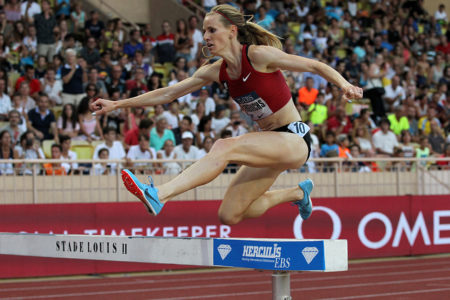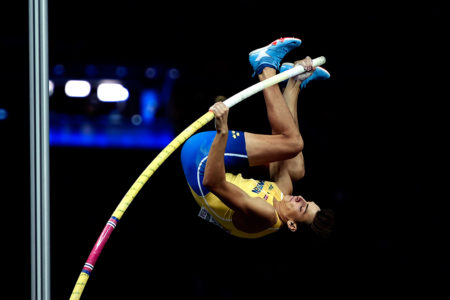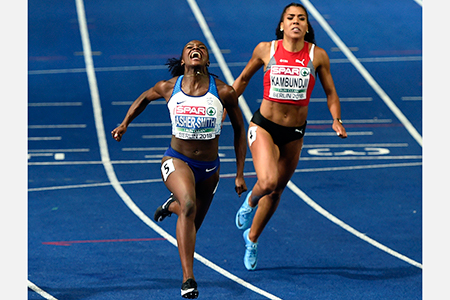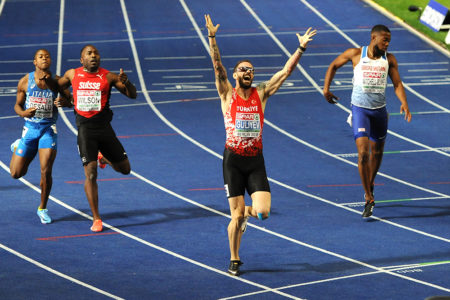Here’s this month’s collection of generally off-track activities that have gone a long way towards shaping the way the sport is headed:

’20 Olympic Trials Back To Eugene
The U.S. selection meet for the Tokyo Olympics finally has a home. Back in the April issue we told you that USATF had pulled hosting rights for the ’20 Olympic Trials from Mt. SAC. Bidding was subsequently reopened and Eugene and Sacramento—who lost out in the original bidding—jumped back into the fray, as did Austin.
In early August, USATF’s Board of Directors chose Eugene, with chair Steve Miller saying, “No domestic event is more important to athletes and fans than the Olympic Trials. The 2020 U.S. Olympic Team Trials is even more critical because it will lead off an unprecedented opportunity to elevate track & field in this country. Having continuity in location as we move from the Olympic Trials into 2021 will enhance and amplify everything around the sport in the United States, from marketing and promotions to operational efficiencies.”
USOC Chief of Sport Performance Alan Ashley said, “The USOC is pleased with the selection of Eugene as the host of the 2020 U.S. Olympic Team Trials. From a performance perspective, the USOC’s top considerations are that the Olympic Trials provide the best competitive experience to athletes and serve as a platform to select the best Olympic Team possible. Eugene is a well-established host, and we look forward to the 2020 Olympic Team that will be selected there.”
For his part, TrackTown USA CEO Michael Reilly said “We could not be more excited to host the 2020 U.S. Olympic Trials. We are confident that the Eugene-Springfield community, our public and private partners, and the fans who travel from across the country will ensure an extraordinary atmosphere for this event. A new, state-of-the-art Hayward Field on the beautiful University of Oregon campus will be a perfect setting for the athletes striving to become a part of the World’s #1 Track & Field team.”
All this assumes, of course, that the new Hayward Field is ready in time. Not that we’re suggesting it won’t be. Construction has been going on steadily ever since the NCAA wrapped up. With the existing structures all gone, by mid-August an excavation company was averaging 750 cubic yards (60-75 dump trucks) of dirt removal per hour.
USATF Foundation Comes Up Big
Elite athletes got a big boost from the USATF Foundation in July when the group awarded $875,000 in Schwarzman Grants to 25 high-end performers who expect to be in the mix in the approach to the next World Championships and Olympics. The grants are named for Blackstone CEO Stephen A. Schwarzman, who last year donated an unprecedented $2.5 million to the cause. This year Schwarzman donated an additional $250,000 to raise the amount of each grant to $35,000. The grantees:
Men: Ronnie Baker (100), Zack Bazile (LJ), Paul Chelimo (5000), Ryan Crouser (SP), Paul Dedewo (400), Mason Finley (DT), Darrell Hill (SP), TJ Holmes (400H), Reggie Jagers (DT), Shadrack Kipchirchir (10,000), Kenny Selmon (400H), Christian Taylor (TJ);
Women: Gwen Berry (HT), Erica Bougard (Hept), Kendall Ellis (400), Maggie Ewen (SP/DT/HT), Phyllis Francis (400), Tori Franklin (TJ), Georganne Moline (400H), Sandi Morris (PV), Katie Nageotte (PV), Keturah Orji (LJ/TJ), DeAnna Price (HT), Raven Saunders (SP), Shakima Wimbley (400).
In addition, another 45 athletes were given Elite Athlete Development grants of $5000 each. The total given by the foundation is over $1.3 million this year, the first to surpass the million-dollar benchmark.
McLaughlin Signs With Major Talent Agency
Everyone knew Sydney McLaughlin was going to go big-time after a one-and-done frosh season at Kentucky. An NCAA title, a 52.75 World Junior Record and a stunning set of marks including 11.07w, 22.39 and 50.07 just bolstered a résumé that included making the Olympic team as a high school junior, so it was no surprise when she announced in Eugene in June that she was turning pro.
While several months later we still await news of a shoe contract, the new professional has signed to be represented by William Morris Endeavor, the high-power agency that also works with Allyson Felix, tennis star Serena Williams and actor Denzel Washington. There has also been no word on the World Junior Recordholder’s training future. At one point in June she had said she would be following coach Edrick Floréal from Kentucky to Texas, but in late July TV commentator Ato Boldon said that she won’t be changing locales. And she has enrolled in the fall semester at Kentucky.
High Tech Indoor Facility Coming To Chicago
America’s second city will soon have a banked indoor track as Chicago has broken ground on a $55 million facility on the South Side. The project, pushed for 35 years by activist and Northeastern Illinois professor Conrad Worrill, will feature a hydraulically banked 200m track with an interior straightaway, field event and warm-up areas.
The 139,500 square-foot facility will be located in Chicago’s Gately Park, and be designed for use by a variety of sports throughout the year. In addition, it will host after-school and summer programs for teens. “It’s an opportunity to put Chicago track & field on the map,” said Worrill. The facility is expected to be completed in August ’19.
More Golds For Semenya
Two more medals of the highest order are on their way to Caster Semenya, just weeks before a new IAAF hyperandrogenism ruling might make it harder for the South African great to win such honors in the future. CAS has agreed with the drug testers and stripped top-of-the-podium spots from the ’11 WC and ’12 OG from Russian 800 runner Mariya Savinova. Both of those races saw Semenya finish in the runner-up position. The ruling gives Semenya a total of 3 outdoor World titles and 2 Olympic golds. She is the first woman ever to win twice at the Games.
Savinova will also be stripped of the ’10 Euro title in addition to getting a 4-year ban. CAS pulled no punches in its ruling, saying, “The athlete has distorted multiple high-level competitions, damaged numerous other athletes and has breached the applicable rules on many occasions using multiple different substances and did so in full knowledge of the circumstances.”
Savinova’s positive test did not come from the Olympic retests that reassigned so many medals, but rather as a result of film of her talking about doping in the German documentary that revealed the Russian doping program. Subsequently, blood samples in her biological passport were reexamined and found to be out of whack.
Some Rule Changes For NCAA Track
The NCAA’s Playing Rules Oversight Panel has signed off on a June recommendation by the Track & Field Rules Committee for some rules modifications. Henceforth, the NCAA will mirror the IAAF/USATF changes of this year and expanding the exchange zones in the sprint relays. In the 4×1 and 4×2 the zones will all be 30m. In the sprint medley, the first zone will be 30 and the rest will stay at 20. The changes are set to go into effect next season. On the surface, not much will change, as the previous set of guidelines allowed for a 10m acceleration area followed by a 20m zone. The vast majority of violations have always occurred at the end of the zone.
Other notable updates:
•All members of a college team must wear the same uniforms (same primary color/same logo) each day of competition.
•Field event competitors now have a 30-second window to begin their attempts, except for vaulters, who will remain at 60 seconds. This also now matches IAAF/USATF standards.
•False-start detection blocks have now been approved for NCAA use.
Lilesa Coming Out Of Exile

You can go home again after all. That’s what Ethiopia’s Feyisa Lilesa has decided 2 years after he crossed the finish in the Olympic marathon with his arms crossed in protest against his government’s treatment of his Oromo tribe. Since then, the silver medalist has stayed in the U.S. in a self-imposed exile, his family joining him last year.
However, things have changed in his homeland now that the new prime minister, Abiy Ahmed, is not only a reformer but a member of the Oromo as well. Ahmed invited the runner back, and the country’s Olympic committee and its athletics federation sent a joint letter promising him a “hero’s welcome.”
Said federation head Haile Gebrselassie, “He was born fearless. I knew him personally, and I was close to him. And he questions why people should be oppressed. He stands up for his people.”
What To Do About Tokyo’s Weather Conditions
The heat at the ’20 Olympics is going to be a problem, but the Japanese are working overtime on possible solutions. Their motivation is high, given this summer’s heatwave that has caused more than 125 deaths in the island nation. In late July, a temperature of 106 (41F) was recorded, a record for Japan. The heavy humidity in Tokyo compounds the risk. The Games, set for late July-early August, will be a bigger weather challenge than the ’64 version, which was held in October.
With the marathons already set for 7am, the president of the LOC has met with the prime minister to discuss a shift to daylight savings time to put the runners another hour away from the worst heat. Tokyo city officials are also experimenting with watering the pavement to see if that will bring temperatures down along the road courses.
Among the other solutions being discussed:
•Large tents and cooling fans for spectators waiting in line.
•Air-conditioned rest areas at all venues and dining areas.
•Solar heat-blocking pavement along the road courses.
•Reduced working hours for employees and volunteers.
•Allowing spectators to bring drinks and umbrellas.
The Japanese aren’t the only ones looking for answers. The Canadian team tested a high-tech “pill” during the early-August NACAC meet in Toronto. The pill is actually a feedback sensor with Bluetooth technology from which scientists can download information that will help them figure out a race plan based on core temperature limitations.
“It’s a bit of science,” said one of the designers, “it’s informed, but it’s still a bit of art.”
After Eugene 2021, Where Next?
The ’19 World Championships are slated for Doha, Qatar, and 2 years later the IAAF’s biggest meet moves on to Eugene. What about ’23 and onwards?
Well, that meet falls under a new protocol the IAAF announced early in ’17. An IAAF statement explained, “Council approved a proposal made by Sebastian Coe to no longer continue with the formal bidding process by which the IAAF has traditionally attracted applications to host IAAF World Athletics Series competitions, including the IAAF World Championships. In future, the IAAF will now assess the strategic goals for growing the sport in relation to each IAAF competition, targeting cities from countries and regions which will best assist the delivery of those aims. The aim is to create a true partnership matching the hopes and ambitions of potential hosts with those of the IAAF.”
At its meeting this July, the Council gave a leg up to Budapest, announcing, “Under the new bidding rules, the Council was informed of the discussions with European cities and approved the recommendation that Budapest be declared the preferred European city to host the IAAF World Championships in 2023. The process now is for a full technical, financial and risk evaluation to be undertaken with the results presented to the Council in December. At that stage a final decision will be made.”
And 2025? Speaking in Nigeria just before the opening of the African Championships, Coe raised the subject of that year’s Worlds being hosted by an African city, saying, “I made a promise when I became president and that was to try and bring as many events as possible to Africa.”
More Criticism For IAAF On Testosterone
The IAAF’s potential coming rules on hyperandrogenism came under heavy fire in July as Human Rights Watch—the prominent international advocacy group—demanded the international governing body “urgently revoke these regulations.”
In an open letter to Seb Coe, the group stated, “Instead of upholding the legitimate objective of ensuring that each athlete is qualified to compete in the appropriate category in sports competitions, the IAAF’s new regulations violate internationally-protected fundamental rights and discriminate against women on the basis of both their sex and their sex characteristics, violating their privacy, and having the effect of coercing them into unnecessary medical procedures.”
This will be tough criticism for the IAAF to brush off; Human Rights Watch, founded in ’78, won the Nobel Peace Prize in ’97 for its work against landmines.
More than 60 members of the Women’s Sports Foundation, which includes tennis legend Billie Jean King, have also come out in opposition to the new rules, stating that, “no woman should be required to change her body to compete in women’s sport.”
More Rebuilding In Eugene
Collegiate track in the Pacific Northwest may look a lot different next year. It’s not just that Hayward Field will be out of commission during its rebuild. It’s that personnel changes have rocked the Oregon program.
Distance coaches Maurica and Andy Powell were both hired away by Washington. Maurica will be the Huskies’ new director of track & field and cross country (and Duck mile legend Matthew Centrowitz will be joining them as a volunteer coach). Reportedly at least four Duck All-Americas have been given their releases and will move to Seattle: Tanner Anderson, Lilli Burdon, Katie Rainsberger & Mick Stanovsek.
According to the Eugene Register-Guard, a number of recruits may also have changed their minds, among them Josh Hoey, the HS Recordholder in the indoor 800 at 1:47.67. Yearly mile leader Brodey Hasty (4:00.05) has been released from his letter of intent and instead signed with Northern Arizona.
Head coach Robert Johnson has hired Helen Lehman-Winters (USF) and Ben Thomas (Virginia Tech) to coach the distance runners.
Not All Went Smoothly At African Champs
While the African Championships in Asaba, Nigeria, featured some terrific races, it also served as a cautionary tale in how not to put on a major meet. Perhaps Asaba was a bad choice in itself. The city of 150,000 features an international airport but no scheduled flights to the capital of Lagos, through which most of the international competitors would be flying.
Officials arranged charter flights to ferry athletes and coaches to the meet 270M (c430K) away, but because they were running up to 3 days behind, many events had to be rescheduled while hundreds of athletes slept in the Lagos airport. The Tanzanian team, tied up with communication and visa issues, didn’t even come.
The track, literally, had bumps in it, causing some sprinters to slow things down to avoid injury. The lighting at the stadium did not work, so evening events had to be canceled. The bathrooms had no water supply. The scoreboard did not work.
The Kenyan federation, which put on the successful IAAF World Youth Championships last year, was said to be furious with the treatment of its athletes. Said one top officials, “It is beyond our comprehension why Asaba was given the rights to host an event of this caliber without putting into consideration the logistics.”
On the bright side, the 5-day meet featured throngs of excited fans, selling out the 22,000-seat stadium each day.
The Latest Chapter Of War & Peace…
The long-running Russia saga appears no closer to a conclusion as the IAAF Council has decided to keep the Russian Federation on the banned list at least until its December meeting.
Three requirements remain for the Russians to meet:
•They will have to pay the IAAF’s costs for the Taskforce and all of the cases that have gone before the CAS. The Russians have already agreed to this and are waiting for a final accounting.
•They will have to accept the findings of the McLaren and Schmid Commissions that the Ministry of Sport was behind the doping and subsequent coverup. So far this has been too big of an ask.
•They will also have to provide access to all of the data from testing at the Moscow lab 2011–15 so that the governing bodies can determine if there are any other individual cases that need to be pursued by the authorities.
Reportedly, WADA has been negotiating with the Russians on some of these points and may produce a breakthrough at its September meeting.
High-Risk Doping Nations Singled Out
With an eye toward moving the sport beyond the Russia scandal and the resulting public relations nightmare, the Athletic Integrity Unit will be making federations more responsible for anti-doping practices. Nations are being put into three categories based on their level of success and perceived risk of doping. Category A represents the biggest risks and currently includes Belarus, Ethiopia, Kenya & Ukraine. Russia, ostensibly, will be added to this list once its suspension is lifted.
Athletes from the category-A countries will have to undergo 3 out-of-competition doping tests in the 10 months prior to a global championship. They nations also have to provide mandatory education for athletes and support-people.
According to the IAAF, Category B will include the other federations who are competitive at international level. Category C will include federations with very few international-level athletes.
The new guidelines, approved by the IAAF Council at its July meeting, also expand the authority of the AIU. Previously, its powers only applied to individuals, but now it will be able to investigate federations and monitor their compliance. Said AIU chair David Howman, “The IAAF Council should be congratulated for adopting innovative new rules that also make all of its member federations accountable on anti-doping matters.”
At NACAC, A Win Was Just A Win
If you won your event at NACAC, it would have been nice to get a Wild Card entry—or even an automatic A-standard—to the World Championships next year. That, however, won’t be happening, says the IAAF.
Some investigative reporting by Lincoln Shryack of FloTrack found that both USATF and NACAC advised athletes in writing, that the winner of each event “will qualify with the A-Standard for the 2019 IAAF World Championships in Qatar and 2019 Pan-Am Games in Peru.”
Once people in Toronto started talking about this, the IAAF was quick to crush that false hope, explaining, “In the past the winner of the Area Championships was deemed to have achieved the entry standard (not a Wild Card) for the next World Championships, but that will no longer apply under the new world rankings system, as the world rankings will decide qualification.”
FloTrack said it had spoken to at least 2 American athletes who had competed in Toronto who believed a victory was indeed equivalent to an automatic qualifier.
Morris Sees Women Vaulting 17-Feet
Jumping in her hometown of Greenville, South Carolina, inspired Sandi Morris to share the heights of her visions. “My outlook is I truly believe that women can jump 5.20m [17-¾],” she said. “I really do believe that. And that belief drives me to want to prove that, and to jump as high as I physically can.”
Analyzing her shots at a World Record 16-7½ (5.07) she told Simon Turnbull of the IAAF, “That’s the closest I’ve ever been to making 5.07. Two of my attempts were really solid. I was over most of the way. I just didn’t quite have the depth behind the bar to make it completely over.” She added, “Am I the one who’s going to jump 5.20? I don’t know. I would like to think so. I think I’ve got the speed to definitely break the World Record, the strength to break the World Record. I don’t know what my top end is but I’m definitely going to push myself until I find out.”
As Morris told T&FN last year, “Who knows what women are capable of jumping? Men have been at it a bit longer than women have, so I think that I wouldn’t be surprised if in the next 10 years we see a couple of women around 17-feet.”






